If it were raining, you could be entering a scene from Blade Runner with the darkness of night pierced by bright neon lights of billboards. But there is no rain, rarely does it rain; they say it has not rained properly here in years. The night air is cool and thick with the pungent smell of exhaust on the freeway. Faster cars with young male drivers (always) are swerving in and out of other vehicles: there seems to be no point in having lanes but they are painted there anyhow (sometimes). You are driving down Al-Ourba road from the airport towards Cairo. Uber cannot enter the airport parking so you wait at Le Meridien as the guy on the plane told you to do. Now you are on Saleh Salem Street and your driver is smoking sternly with the windows down. The speed limit is 80km but no one seems to care about the potential 400 EGP fine. The air gushing past is refreshing and now you are turning right and rolling up onto the 6 October overpass that goes on for kilometers above the megapolis. There are billboards on either side of the overpass promoting Toshiba, Pepsi-Cola, Etoile, Sa’ada, Sheraton, Amazon.eg, la Germania kitchen genius, KFC, some local TV show, Orange mobile provider that is charging you extra roaming fees (already), DMC TV shows, Mercon, Nestle Pure Life water, and then darkness. No more lights except the white streetlamps stranding like tall skinny sentries marking the trajectory of the road ahead and the red brake lights of all the cars moving like cellular molecules along a fully enclosed vessel of black membrane. Below the overpass, more red cells moving slowly, distant honking. Then more ads for Eid foods and Bloomfields signature rooftop experience, Geely electrifying tomorrow, MBC comedy shows, Clorox, Open Air Mall, Mobil 1, and Arabia Sun Capital… “Mosaics,” the driver calls the billboards: “money,” he smirks: during the end of Ramadan, there are more ads because people have more will to buy things. Ramses Station is below you and the smell of barbequed meat comes wafting up. Humans are moving around slowly, soundless beneath the hum of the wheels on bumpy tarmac and the constant sporadic honking. You pass derelict abandoned buildings with empty windows, and then the empty frames of huge standing billboards, rusted ruined stranded assets by the side of the road. Then you reach the mighty Nile, black in the night.
*
Gray in the morning, the Nile is a metallic blue gray moving effortlessly around Al-Rawda/Manial and Zamalek islands of Cairo. The city is shades of beige brown, everywhere there is dust and a thick blanket of exhaust spreads across the urban sprawl, mauve and pink in the sunset seen from the eastern Mukattam hills. You have been here before in a distant dream, decades ago you walked the streets in the sweltering summer heat, beneath the blazing sun, relentlessly beating down on everything, making mush of minds and melting bottle caps into the asphalt that moved beneath the weight of your feet walking, and the delicious fresh mango juice on your taste buds that still remember Cairo every single time you have mango (which is not often…).
Now you are on another overpass going over Attaba – supposedly the most populated place in Cairo – which seems unlikely as all places in Cairo seem crowded and all the buildings along the way are rundown, brown, dusty, broken shudders, and empty windows. The dystopia is real. The Kobri Al-Azhar overpass ends and the driver drops in front of Al-Azhar Mosque, indicating that you have to go under the road through a tunnel to the other side to reach Khan al-Khalili, but first you attempt a stroll around the mosque. You make it 20 meters along the wall and stray dogs have squadrons of flies around them, some lying prostate on the ground; a butcher is lugging a flank of meat from the back of a mini pick-up truck, a rib cage, and the head of the beast is lying there too, black hide and blank eyes.
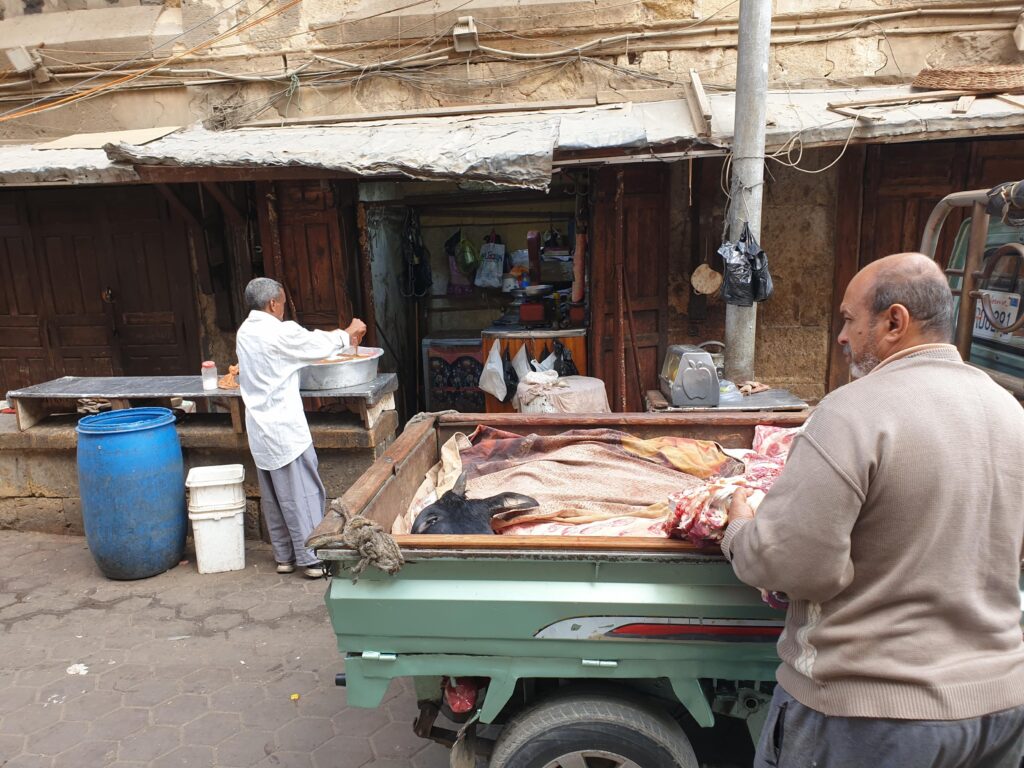
In the Khan al-Khalili quarter, you get the customary ‘Welcome’ from the few shops that are opening. The streets are lined with stores that are mostly closed gray and brown and dusty metal shudders that have seen better days if some of them have seen those days at all. Pale silver and gold plastic stringers connect the buildings in an attempt to adorn these sad streets. Eid El-Fitr is coming, the end of Ramadan is near, people are tired of fasting, its exhausting to not eat all day and then to stuff yourself in the evenings, you change your schedule to be able to withhold the urge to eat all day, some sleep deep into the day, some invert nigh and day completely.Without knowing it at first, you are on the famous Al-Muizz Street, a street with no sidewalks, just a thin step that serves as a sitting stoop for shopkeepers when they are waiting for business. A pair of veiled women are strolling down the middle of the road beneath the stringers fluttering a little in the morning breeze. You are suddenly upon the Qalawun Complex (built in AD 1284-1285 at a record pace). On the left, you see the sign in blue letters that indicates the ophthalmology hospital. An old guy in gray cotton djellaba sits on his stoop. He looks at you through thick smudged glasses when you mention ‘maristan’ and he nods. This is where the bimaristan used to be until it was replaced mostly by the modern ophthalmology hospital in the early 20th century.
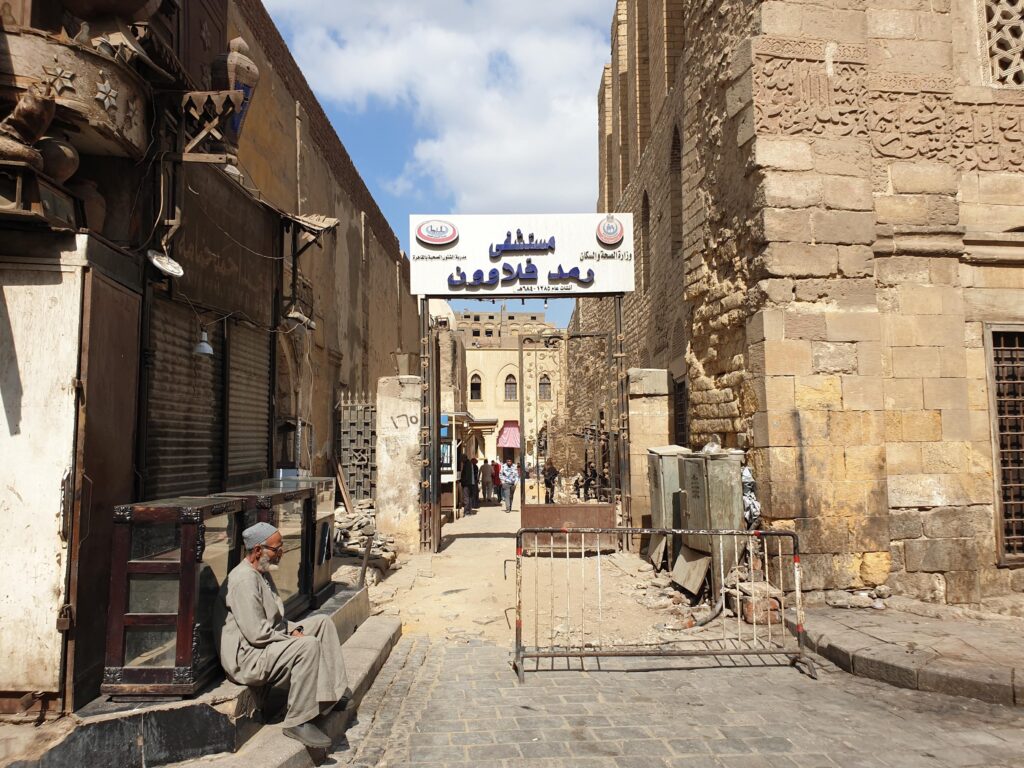
You walk past a moving metal gate under the blue and white sign and walk through a rusted metal gate that is half open. The path is sandy and littered with broken stones. Sitting in a container with a window behind the Qalawun Complex is a surly security guard who asks your nationality. You are Belgian here and keep walking towards the new hospital. You get to the parking lot that is demarcated by old arches potentially from the original bimaristan and you are taking a photo with your phone when the security guy shouts mamoua’ (forbidden). The all-pervasive mamoua culture surges from the past and you ask the guy why is it forbidden to take a photo of a parking lot?
At the Muizz Street ticket office, the pricing is 10 EGP (guineas) for locals and 180 EGP for foreigners which is a big difference, even greater than the times ten factor in India. It’s payback for the colonial period, but still it dissuades you from paying so you stroll up Al Muizz Street without the intention of entering all the historical sites, and there are many. Along the street, there is a cool-looking café called Okka Coffe that has benches outside and posters of Egyptian singers like Umm Kulthoum from another era along the outside walls. You would have stopped to have another morning coffee there but it was closed. Further on, some beautiful wooden window box lattice work – the famous mashrabiya – that is depicted so well in the novels of Naguib Mahfouz with the flirting scenes of adolescent love (or curious lust) gazing down through the holes in the diaphanous shutters to see who is loitering below. But no young love is in the air this morning, just some more security guys in matching blue jackets are sitting in plastic chairs, smoking, looking at their phones, or dozing.
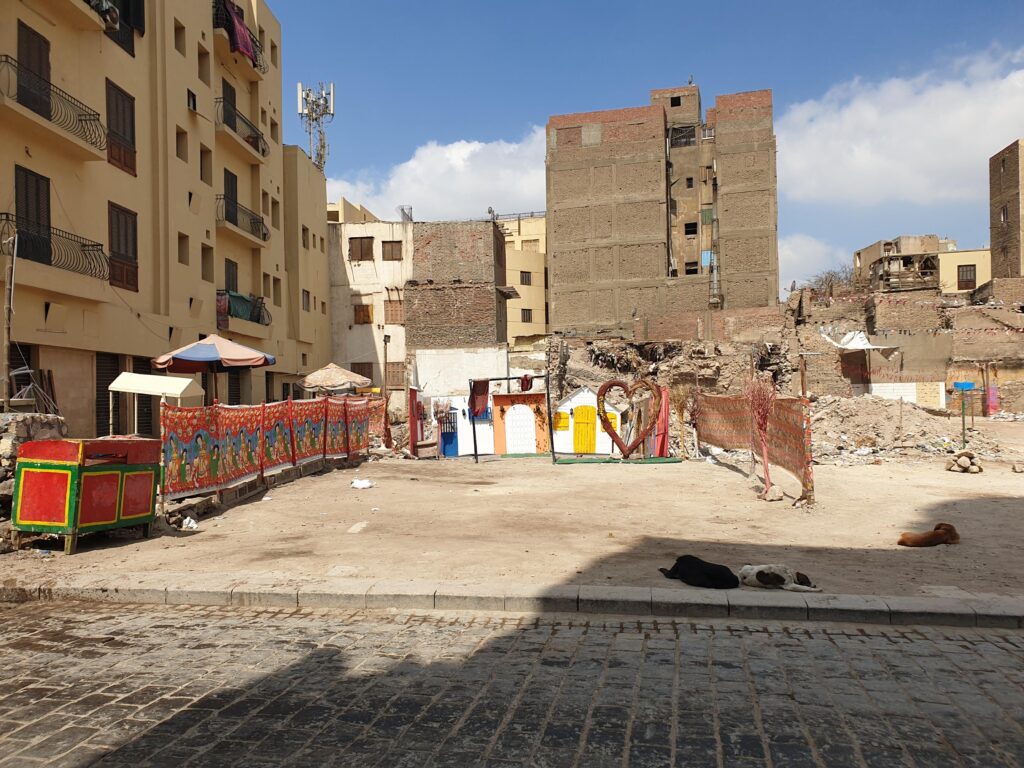
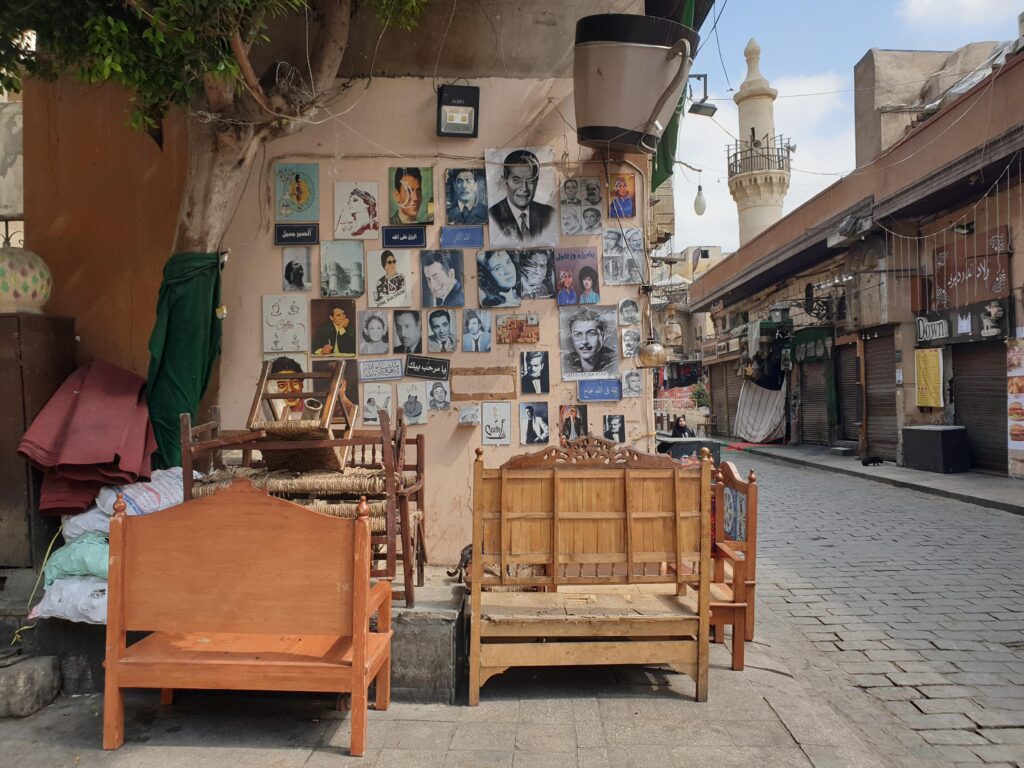

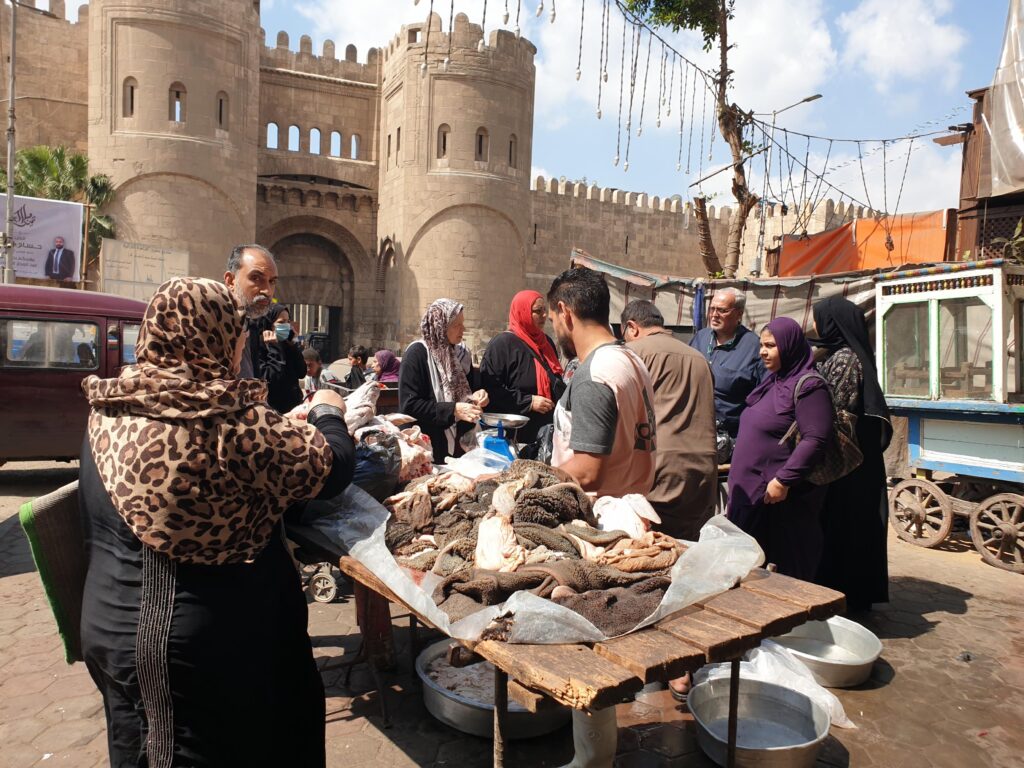
The street widens and some dead olive trees line the sidewalk in front of another mosque. Another blue group of young security guys sits around in a circle by a moveable metal grate and a metal detector machine that no one seems to use, ever. They wear the brand of A.S.S.C and the main guy has a black jacket with a badge stitched onto his left chest pocket; the badge has a wolf and the eye of Horus on the top right of the continent of Africa. Strange combination for a logo. You pass through the imposing gateway of Bab Al-Futouh that is flanked by massive towers. This Gate was one of eight that connected the mudbrick rampart walls protecting Fatimid Cairo. The road is bleached out by the sun and covered in dust and dirt that cause small clouds in the wake of car wheels going by. On the other side of the road, a small group of people are congregating around something on display. You cross the divider in the road that an old, veiled woman dressed in black is struggling to climb and crawl over. The security guys beneath the arrows slits and burning oil machicolations of the Bab are oblivious. The group of men and women are huddled around two wooden tables on metal legs that are covered with pieces of dead sheep, including a pile of their severed heads laying there in the sun: gray, blue, white – bloodless. Poverty is palpable.
*
Back at the wooden-barred ticket window, you pay the 180 EGP and a ‘guide’ loitering around invites you to visit some monument. You decline and head straight across the street to enter the Qalawun Complex. Qalawun was the eighth Mamluk sultan, and the second major sultan after al-Zahir Baybars (r. AD 1266–1277) who is considered the founder of the Mamluk state. As an elite military force, the Mamelukes came to power after being invited by Sultan Salah Al-Din to help repel the Crusaders; after having helped do so, the Mamelukes took power themselves.
Qalawun ruled for a decade from AD 1279 to 1290, having begun his career during the reign of Baybars. His rule was grandeur and his Mausoleum attests to the prestige he bequeathed himself: a massive tomb encased in a wood-latticed fencing sits majestically in the middle of the vault that ascends to the dome that is a derivative of the Dome of the Rock in Jerusalem. The connection across territory and time is made and his place in history is consolidated and consecrated. Qalawun was the grandfather of Sultan Hassan – you will see his complex tomorrow.
This impressive vault leads to a smaller room and corridor with a high ceiling that gives onto a courtyard where the water treatment and women’s quarters of the maristan were located. Hazm the caretaker explains that the patients were brought here to be washed and cleaned in the basin of water with ‘chemicals’ which you interpret as being for cleaning the skin. After receiving treatment, the patients were allocated individual rooms where they could rest in the shade. Small corridors pass behind the rooms allowing for ventilation to keep the air clean. You can imagine the birds chirping happily in the trees and a soft breeze blowing softly across the courtyard.

The women’s quarters were adjacent to this washing resting area. A Roman capital rests by some debris that you climb onto to access the low brick walls that delineate the contours of where the rooms used to be. You jump from wall to wall and make your way along the passageway that separates the women’s rooms until you get around the other side where an 8-pointed star formation is embedded in the ground. This was a water basin for washing and resting as well. Imagine women sitting around the basin chatting and feeling the coolness of the water on their feet and toes. A stray dog appears on the wall separating the maristan from the rest of the world and looks down at the new patient, then it disappears.
Hazm shows you around the side of the building where the shadriwan (wall fountain) would have brought water into the maristan. Sitting next to the little canal is a random Roman tub made of rugham (marble). Hazm flicks it aside with his hand and points to the mini ‘aqueduct’ canal on the ground that would have carried the water in a straight line directly across the courtyard to the Iwan Al-Akush that is the only other remaining piece of the maristan that was not overtaken by the new ophthalmology hospital. The only water now is in a red plastic bucket lugged over by a cleaning woman that greets you both cordially. The Iwan Al-Akush is across the open courtyard where some people sit in the shade talking. Hazm pushes open the large door and dust covers everything: the Iwan is in a sad state with trash and pigeon droppings everywhere except for the high-arched windows that give onto the hazy blue-gray sky of Cairo.
*
The narrow streets of the Khan al-Khalili are packed now. The midday prayer erupts loudly over some invisible speakers calling the believers to their duty. Veiled women with bundles push past you. A stream of people is moving slowly in the other direction. You have to go with the flow or you will be pushed out of the way. There are mannequins with blond wigs and legs of mannequins with tight stretch pants. There are bras of all different bright colors on coat-hangers and dresses that young ladies are turning around and holding up. Fruit and spices and vegetables are on display; some guys are screaming out discount prices to everyone and no one. There are stray dogs and children moving around the knees of people pushing their way across the trash on the ground. So much trash on the ground that it just becomes part of the décor. And so many fireworks for sale in rectangular cardboard boxes covered with colorful images of the Joker from Batman, Zidane the football player, Japanese manga characters, and Winnie the Pooh. It’s almost Eid El-Fitr, marking the end of Ramadan, when children and young adults will have fun setting off fireworks.

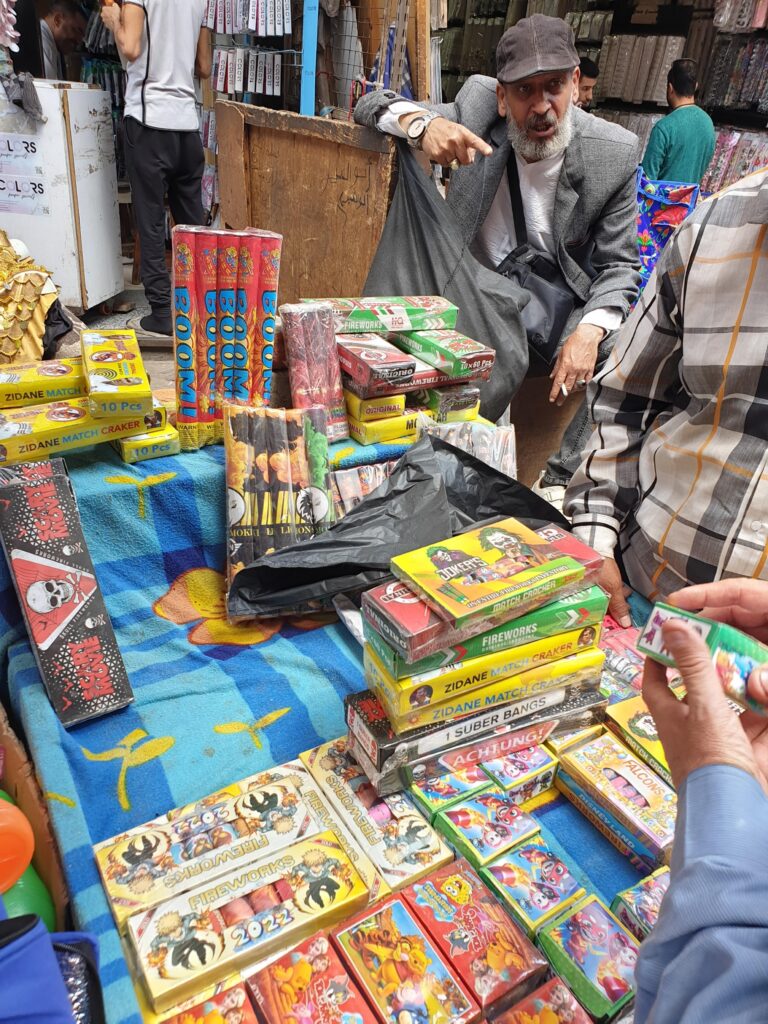
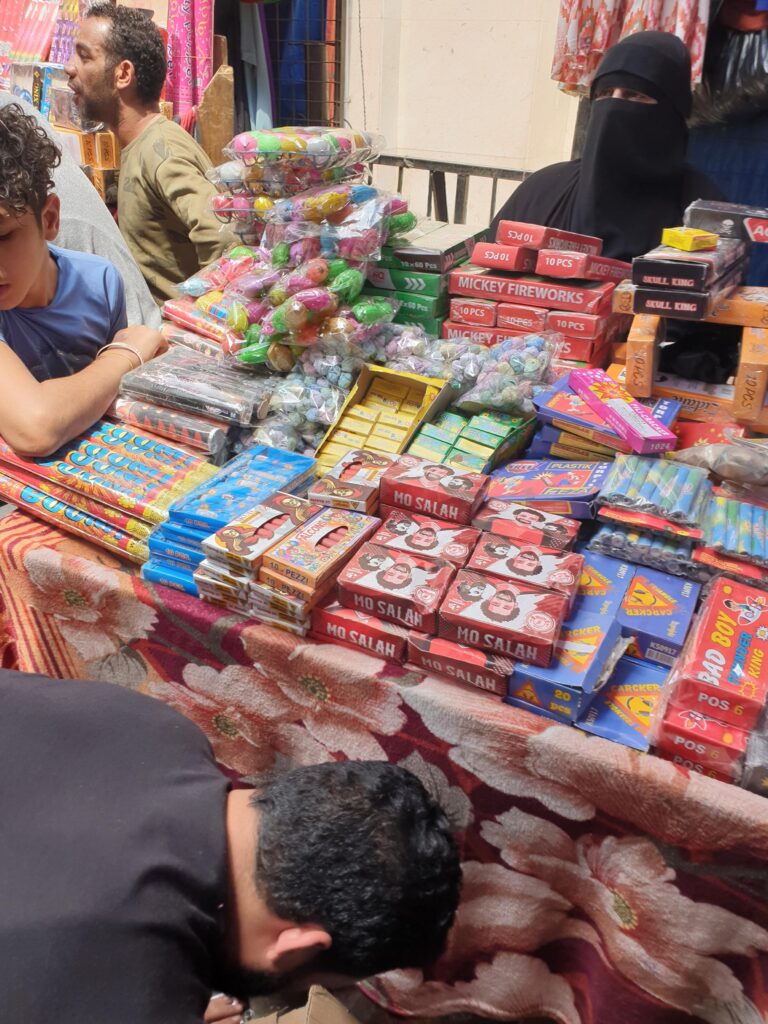

At the Cairo Museum of Islamic Art, you meet a young lady name Fatima who is working at the Information desk. She is studying history at Al-Azhar University and she is eager to teach you some things that are not written on the description plaques for visitors. In the medicine section, she runs you through the different tools used by physicians for operating on patients that resemble many of scalpels for cutting and needles for sewing that we have today. There are talismanic bowls with incantations written on the ceramic. ‘Magic bowls’, she says and explains how patients would drink the water or milk to help with the curing process. The paganism of sorcery pre-dates the monotheistic religions and many of the herbal and ‘magical’ treatments found their way into mainstream medicine until modern science eradicated the magical part of things to give a more rational and precise answer. Hanging behind the glass partition, Fatima points to a ‘magic shirt’ covered with red script lines from the Qur’an and explains how the thin beige tissue can help the sick person recover from their illness. “You should watch The Blue Elephant”, she recommends: it’s set in modern times at the Abbassiyya mental hospital and references the talismanic tunic.
In an adjacent room, there is parchment drawing of a blue elephant from India carrying a wooden structure on its back, containing a woman sitting on a lion-decorated pedestal with the black-bearded driver on the elephant’s neck; above the women another man is sitting on the edge of the roof of the wooden frame looking up at the countryside before him; behind him is a royal peacock proudly showing its tail feathers to whomever is coming behind this impossible contraption. “A blue elephant,” you say and Fatima laughs. Next to the elephant there is a glass-encased display with copper and golden astrolabs testifying to the scientific advancements of the medieval times for the Islamic civilization was in full bloom and surpassing the previous techniques of mapping and measuring time and space. And there is the incredible Book of the Knowledge of Ingenious Mechanical Devices by Al-Jazari.
Looping back around to the Information desk, you stumble upon a wall installation of a “Carved Stucco frame of a window with Kufic inscriptions, brought from the Maristan Qalawun“, Egypt, AD 10th century / AH 4th century. This was before the Qalawun’s time when he built his Complex in 1284-85, so this must be the Fatimid era. “That would make sense,” Fatima agrees and from Islamic Architecture in Cairo (p. 97):
“The plan of the hospital must have been cruciform, with four large halls built along the four sides of a courtyard connected by a number of smaller rooms. It most likely was incorporated into the structures of the Fatimid palace.”
Rough timeline in Egypt: the Fatimids (AD 909-1171) followed by the Ayyubids (AD 1171-1250) followed by the Mamelukes (AD 1250-1517). The osmosis of civilizational architectural, literally building on each other, and integrating different elements and influences, each time altering or improving in some way according to the tastes or trends of the time. Fatima smiles and says she has to get back to work. Nice meeting you.
*
The Story of the Crazy Caliph named Hakim has endured through the centuries. He was the sixth caliph of the Fatimid dynasty (AD 909-1171), the earliest and only major Shia dynasty to rule present-day Egypt. Of Ismaili indoctrination and influencers of the Druze sect that persists today in the mountains of Lebanon, the Fatimids ruled a territory from Algeria to Syria and Saudi Arabia. Hakim came to power as a teenager in AD 996 when the Fatimids had moved their capital to Cairo. Like most teenagers, he was an unstable young man probably searching for approval from his peers and most probably under the pressure of being in power and having the responsibility to lead. He is known for making rash and unexpected decisions, only to overturn them subsequently, keeping everyone uncertain as to the direction of his next step and apprehensive of their own positions.
These were the early days of Islam and the power struggles that also persisted throughout the centuries were in their infancy as well. Hakim is known for his brutal repression of Christians and Jews in Cairo which was uncommon given the coexistence amongst the religions throughout the lands of Islam: the Muslims ruled but Christians and Jews were allowed to practice. Hakim’s persecution was not seen well, but then again, he also ordered the massacre of street dogs (their barking is said to have ‘annoyed’ him) in order to clean the new capital of Cairo, and he had the old capital of Cairo (Fustat) sacked and largely destroyed – as an assertion of his new power, perhaps. Many also question his decision to forbid the Christian pilgrimage to the Holy Land and wonder why he called for the destruction of the Church of the Holy Sepulture in AD 1009.
His bizarre behavior may explain a larger regional act at play: confronted with the Abbasids in Baghdad who wanted to thwart an expansion of Ismailism and Shiism at large, Hakim was able to position Cairo as a political powerhouse of his times. In AD 1004, he created the House of Knowledge which surpassed Baghdad’s House of Wisdom as the greatest center of learning. He took to the streets on his donkey and is said to have distributed alms and food to the poor. Like his predecessors, he had mosques and madrasas built, but he was not a great builder. Hakim was more an eccentric mystic who came to be deified by the Druze sect that began praying to him. Their secret holy book became the Kitab al-Hikma (The Book of Wisdom), spun off somehow from the mysticism of Hakim’s nocturnal wanderings.This was still a time of revelations and miracle-makers, reclusiveness and eccentricities were perceived as having the potential for divine intervention. Imagine Hakim wearing his brown hooded-djellaba tied at the waist with a rope, like Juba the Madman, riding his donkey in the evenings up into the eastern Mukattam hills that overlook Cairo, reveling at the view, gaining perspective for his next move, impetuous or not, watching the orange ball of fire unpolluted still disappear behind the city that he ruled. Seeking inspiration in solitude for his unstable mind, there may have been a method to his ‘madness’, maybe his madness was only a myth to embellish his legend, to leave a greater legacy. Caliph Hakim vanished in the night of AD 13 February 1021, only some bloody garments were found by his faithful donkey. In line with Ismaili Shiism, some still await his return.